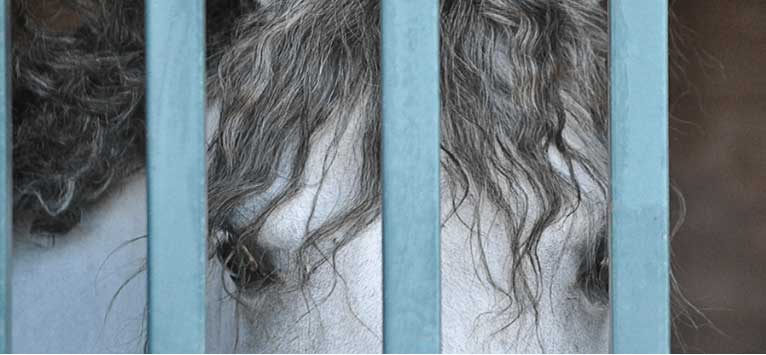
Despite veterinary experts inundating horse owners with information on the link between obesity, equine metabolic syndrome, and laminitis, overconditioning and subsequent obesity are prominent welfare issues. An estimated 50% of horses are classified as overweight, with up to 30% of those considered obese. This problem, however, is not restricted to sedentary horses but is widespread, even among elite performance horses.
In a recent study, nutritionists at North Carolina State University evaluated the body condition scores (BCS) of 377 elite ponies competing at a national hunter competition.* The same two evaluators also assigned a cresty neck score (CNS) to the same ponies.
“The standard nine-point Henneke BCS scale was used, where a BCS of 5 was considered ideal and a BCS greater than 6 was considered overweight. For the five-point CNS, a ‘cresty neck’ was defined as a score of more than 2.5,” explained Ashley Fowler, Ph.D., a nutritionist for Kentucky Equine Research.
“A cresty neck is characterized by fat accumulation along the top of the neck. Studies have found that a cresty neck increases the risk for metabolic issues, such as insulin resistance. Some horses may have a cresty neck without being considered fat or extremely fat (BCS higher than 7), so measuring both BCS and CNS is important,” explained Fowler.
The average BCS of the ponies was 6.7, which is considered overweight. No pony was designated as thin as all ponies had a BCS of more than 5. The average CNS was 2.8, meaning, as a group, the ponies did have cresty necks.
“In total, 93% of the ponies were overweight, with 35.5% of those having a BCS greater than 7,” summarized Fowler.
According to the nutritionists conducting the study, “This is of concern considering the vast amount of evidence to suggest that overweight equids are at a higher risk of disease. Animals with a body condition score of 7 or higher and/or regional adiposity (such as a cresty neck) have a 3-5 times higher risk of developing laminitis.”
Potential reasons explaining the tendency towards obesity include the following:
- Impression by owners that overconditioned animals perform better than underconditioned animals;
- Peer pressure from other owners can affect how individuals approach their own horse’s adiposity and weight-loss efforts;
- Owners are not skilled at evaluating BCS, with studies showing they often do not recognize their horse is overweight or obese; and
- Studies show that even judges “prefer” overweight horses to lean (but not thin) ones.
The researchers stated in their study that the Henneke BCS scale is easy-to-use and that a Google search identified more than 50 YouTube videos when using the search string “horse body condition score.”
Once owners recognize that their horse has excess condition, then a weight-loss program should be initiated.
“Strategies to reduce calories include limiting high-calorie feeds (e.g., grains or concentrates) and reducing the amount of hay offered. While weight-loss programs reduce the number of calories a horse consumes, we want to make sure the rest of the horse’s nutrient requirements are met. Feeding a ration balancer or a vitamin and mineral supplement helps ensure the horse’s nutrient requirements are met while restricting caloric intake,” advised Fowler.
A study by Kentucky Equine Research measured the body weight, withers height, neck circumference, body condition score, and neck crest adiposity of nearly 200 sport horses actively training and competing, and quantified whether body condition was related to resting insulin, glucose, and triglycerides. In this study, pony hunters were significantly fatter than dressage horses, show hunters, show jumpers, and polo ponies, and had significantly higher resting insulin and significantly lower resting plasma glucose values. However, it appeared that overweight sport horses and ponies were less likely to be hyperinsulinemic than sedentary horses and ponies, perhaps because of the training regimen.
This study, titled “Relationship Between Body Condition and Metabolic Parameters in Sport Horses, Pony Hunters and Polo Ponies,” can be found on page 217 of the Kentucky Equine Research Conference 2018 Proceedings.
For additional insights, check out the Body Condition Resources on the Kentucky Equine Research website.
This article originally appeared on Kentucky Equine Research and is published here with permission. Kentucky Equine Research is an international equine nutrition, research, and consultation company serving horse owners and the feed industry. Our goals are to advance the industry's knowledge of equine nutrition and exercise physiology, apply that knowledge to produce healthier, more athletic horses, and support the nutritional care of all horses throughout their lives. Learn more at KER.com.
There a more informative articles in our section on Health & Education.
*Pratt-Phillips, S., A. Munjizun, and K. Janicki. 2023. Visual assessment of adiposity in elite hunter ponies. Journal of Equine Veterinary Science 121:104199.

































